Who doesn’t love a good maple? Maple trees are extremely versatile when used in landscaping. They can become large, brightly-colored focal points or serve well at creating a border between properties. And with over 125 maple trees in the world, there are certainly many to choose from with unique properties and looks.
In this article, we’ll examine two magnificent maples that are popular for landscaping, the Red Sunset® maple and the Autumn Blaze® maple. Both of these trees are utilized so frequently that there doesn’t seem to be a strong alternative. Which is better, then? Let’s dissect the information you will need to make a decision about which one to plant.
Comparing Red Sunset® Maple vs. Autumn Blaze® Maple
| Red Sunset® Maple | Autumn Blaze® Maple | |
|---|---|---|
| Classification | Acer rubrum ‘Franksred’ | Acer freemanii ‘Jeffsred’ |
| Alternative Names | N/A | N/A |
| Origin | Eastern North America | Illinois, United States |
| Description | A common maple cultivar that is deciduous and grows bright red leaves. | A deciduous maple that is a hybrid between the red maple and silver maple. |
| Uses | Mostly used in landscaping as a shade or street tree. | Mostly used in landscaping in residential areas. |
| Growth Tips | Keep the soil moist and fertilize often, especially in early spring and when planting saplings. | Watering vigorously as a sapling will result in a drought-tolerant adult tree. |
| Interesting Features | Can reach 45 feet in height and 35 feet in width. | Can easily reach 60 feet in height and 40 feet in width. |
The Key Differences Between Red Sunset® Maple and Autumn Blaze® Maple
These two trees tend to look kind of similar and they do have a few similarities. They both have beautiful red foliage, grow to about 47 feet in height and 35 feet in width, and form a cone-like shape when mature. However, there are some important distinctions between these two maple species.
Since Autumn Blaze® is more resilient than Red Sunset®, a larger variety of cultivars can be used to grow it. In contrast to the Autumn Blaze® maple that can grow in USDA Hardiness Zones 4 – 8, the Red Sunset® maple may be grown in USDA Hardiness Zones 3 – 8. Red Sunset® grows more slowly than Autumn Blaze®. While the Red Sunset® grows at a maximum of two feet per year, Autumn Blaze® grows more than two feet per year.
The Red Sunset® maple and Autumn Blaze® maple differ from one another in addition to these characteristics. Compared to Autumn Blaze® maple leaves, Red Sunset® maple leaves are significantly larger. While the Autumn Blaze® maple needs a maximum pH of 6.5, the Red Sunset® maple needs a maximum pH of 7.0. Compared to Autumn Blaze®, Red Sunset® maple requires more frequent watering.
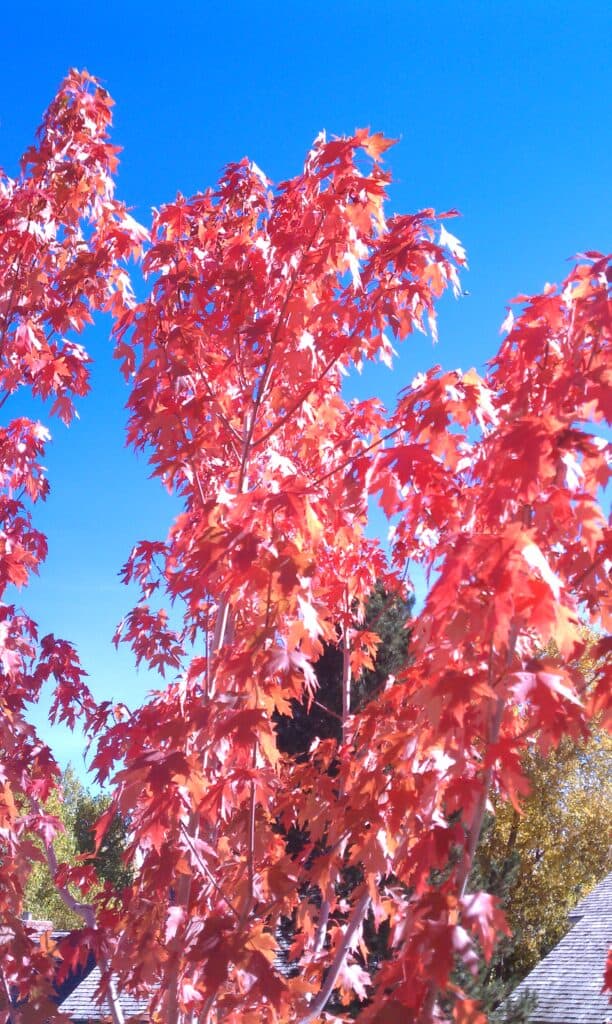
Autumn Blaze® maple, with vibrant fall foliage.
© Dave & Margie Hill / Kleerup / Flikr – License
Red Sunset® Maple vs. Autumn Blaze® Maple: Classification
While both of these maples are part of the same Acer genus, these maples are separate species of trees and even further varieties of their original species. The Red Sunset® maple tree is classified as Acer rubrum ‘Franksred’. The Autumn Blaze® maple tree is classified as Acer freemanii ‘Jeffsred’. Both of these trees are related to a variety of trees in the Acer genus, including the pointed-leaf maple, bearded maple, and Spanish maple.
Red Sunset® Maple vs. Autumn Blaze® Maple: Description
The Red Sunset® maple is a common cultivar of the native red maple tree. The leaves of this tree are gray-green on the underside and dark green on the top, with smooth gray bark that gradually darkens with age. This cultivar is grown for its winter hardiness as well as the depth and consistency of its fall leaves color. When fully grown, this tree reaches a height of around 50 feet. Additionally, because it is more predictable than its native plant, it is a crucial factor for homeowners with small yards who want to know that a tree won’t overtake their homes. It is ideal to plant it in the early spring or late fall.
The Autumn Blaze® maple is a hardy tree that has stunning fall foliage. Its sculptural shape makes it a centerpiece for landscaping a sizable area. This tree is a cross between the natural North American red maple and silver maple. The Autumn Blaze® maple tree matures swiftly and, under the correct circumstances, can grow as much as two feet per year. It has tightly balanced, ascending branches and an oval crown. This type of shade tree tolerates pollution and is appropriate for cities. Additionally, it can adapt to a variety of soil conditions, including those with low nutrient levels. Autumn Blaze® is the name of a maple tree whose green leaves turn an attractive vivid orange-red in the fall.
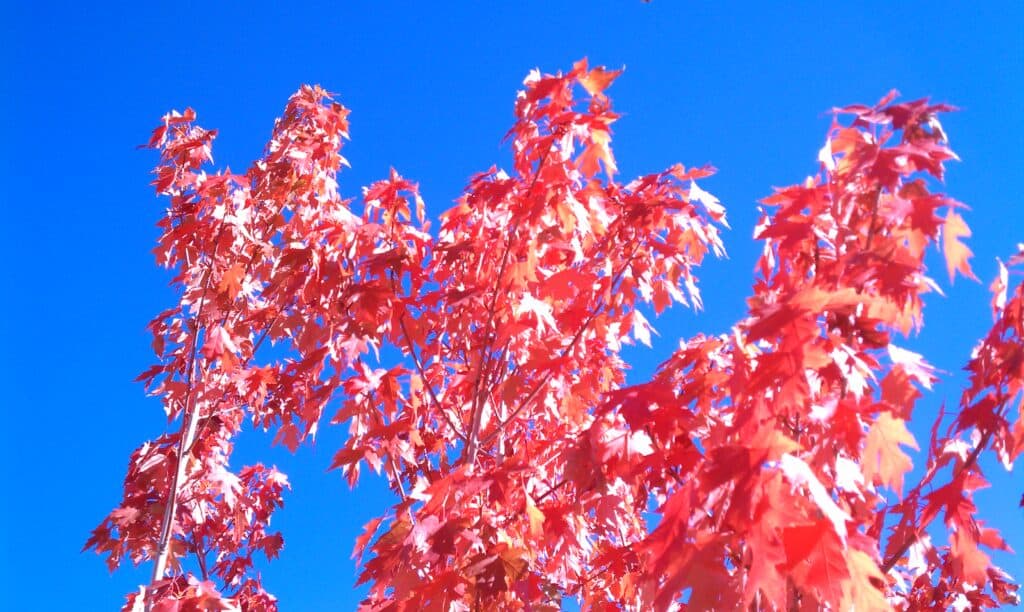
The Autumn Blaze® maple is a hardy tree that has stunning fall foliage.
©Dave & Margie Hill / Kleerup / Flickr – License
Red Sunset® Maple vs. Autumn Blaze® Maple: Uses
Both the Red Sunset® maple and the Autumn Blaze® maple are used for landscaping. In the front or backyard, the Red Sunset® maple tree makes a great shade tree. It has a respectable appearance throughout the year in one’s landscape thanks to the balanced branch structure. The Autumn Blaze® species, on the other hand, can withstand pollution very well, making it the ideal tree for urban areas and residential areas where the air quality isn’t the best.
Red Sunset® Maple vs. Autumn Blaze® Maple: Origin
Native to Eastern North America, the Red Sunset® maple can be found from Quebec to Minnesota, south to Florida, and eastern Texas.
The Autumn Blaze® maple is a cultivar, not a native species, having been created through the mating of red and silver maples. At the US National Arboretum in 1933, Oliver Freeman crossed the breed for the first time with success. The species is actually patented, and breeding is forbidden by law.
Red Sunset® Maple vs. Autumn Blaze® Maple: How to Grow
Red Sunset® is often planted in spring or fall as a potted or ball-and-burlap seedling. Plant it where there is plenty of sunlight and enough room for it to grow to mature size. It favors soil that is rich, moist, yet well-drained and has an acidic pH. This tree can thrive in a low-lying region with regular moisture. Plant it in a huge hole that has been thoroughly prepared and planted at the same depth it is growing in its nursery container. This is particularly crucial if the soil is not sufficiently acidic. To find out if the location is appropriate for this species of tree, as with any tree, it’s a good idea to get a soil study. The root zone can be covered with a three-inch layer of mulch to help keep the root system cool and retain the moisture that this tree needs, but make sure the mulch does not touch the trunk as this can bring pest and disease issues.
The Autumn Blaze® maple tree requires little maintenance, like many large landscaping trees. While the tree is young and establishing itself, maintaining moist soil around its roots is the most important component of care. In late spring or early summer, this tree only needs pruning every other year. Additionally, if your topsoil is already rich, fertilizer is not required. If not, all that is required is a single organic compost amendment right before planting. Planting these trees close to important structures is not advised because this species is highly fragile and short-lived. Although it prefers full sun, it can also do well in some shade, especially if it is planted in a warmer environment. However, place your tree in a location with lots of light if you want it to produce a lot of fall color.
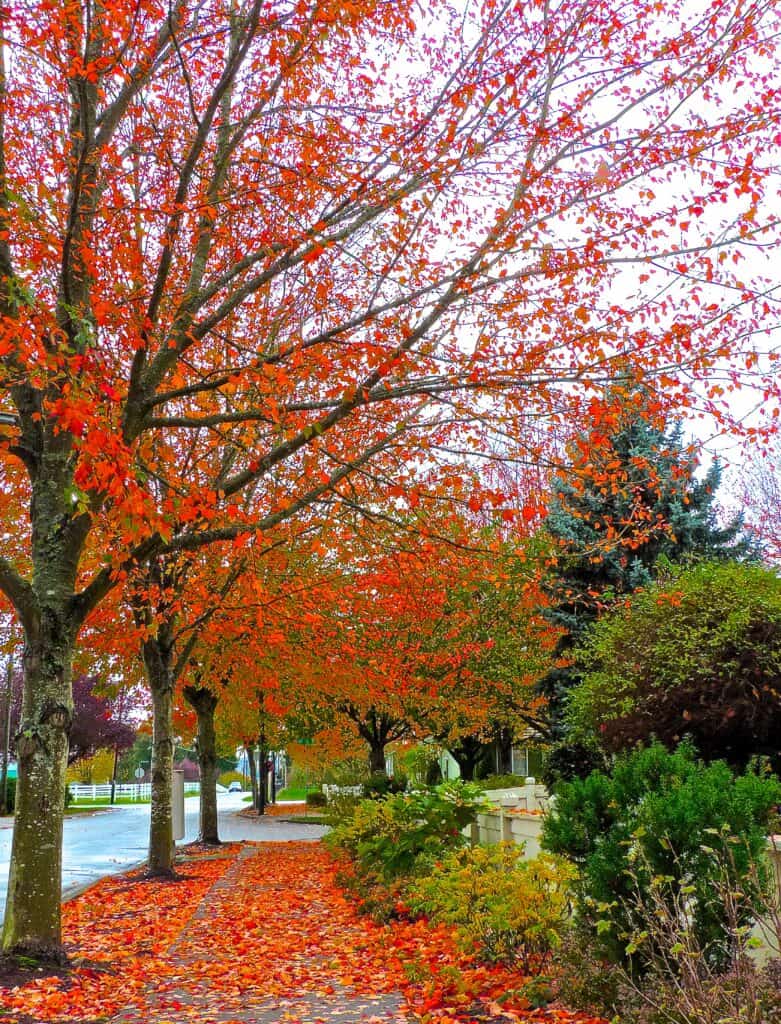
‘Franksred’ (Red Sunset® maple) is a common maple cultivar that is deciduous and grows bright red leaves.
©Peter Stevens / Flickr – License
Red Sunset® Maple vs. Autumn Blaze® Maple: Special Features
The Red Sunset® maple offers exceptional fall color, with leaves that change to vivid orange and red hues. It frequently turns colors initially in the autumn and blooms from winter through spring in crimson clusters of tiny flowers. The Red Sunset® has a good branch structure and produces reddish summer fruit with wings. Like all red maples, the Red Sunset® has extremely sturdy wood that can endure storms.
The fall color of Autumn Blaze® maple trees is well known, and this species is frequently confused with Red Sunset® maple trees and the species of sugar maple. Red maple and silver maple hybrids are called Autumn Blaze® maple trees. Most types of soil can support Autumn Blaze® maple, though it likes damp soil. In the early spring, they yield lovely flowers that can be used for landscaping. These trees rarely bloom at about four to five years old, despite having fragrant, white blossoms.
Both of these stunning maples would make an excellent addition to your yard. If you’re looking for something that grows quickly, we’d recommend opting for the Autumn Blaze® maple. If you would prefer something a little hardier, go for the Red Sunset® maple. Either way, you’ll have a stunning tree that boasts bright red leaves in the fall.
What Other Maple Trees Produce Stunning Fall Colors?
Maple trees are known for producing vibrant shades of red, orange, and gold in the fall that captivate the hearts of folks who appreciate the beauty of autumn. Below is a list of some other stunning varieties of maples that will turn glorious autumnal shades.
Sugar Maple (Acer saccharum)
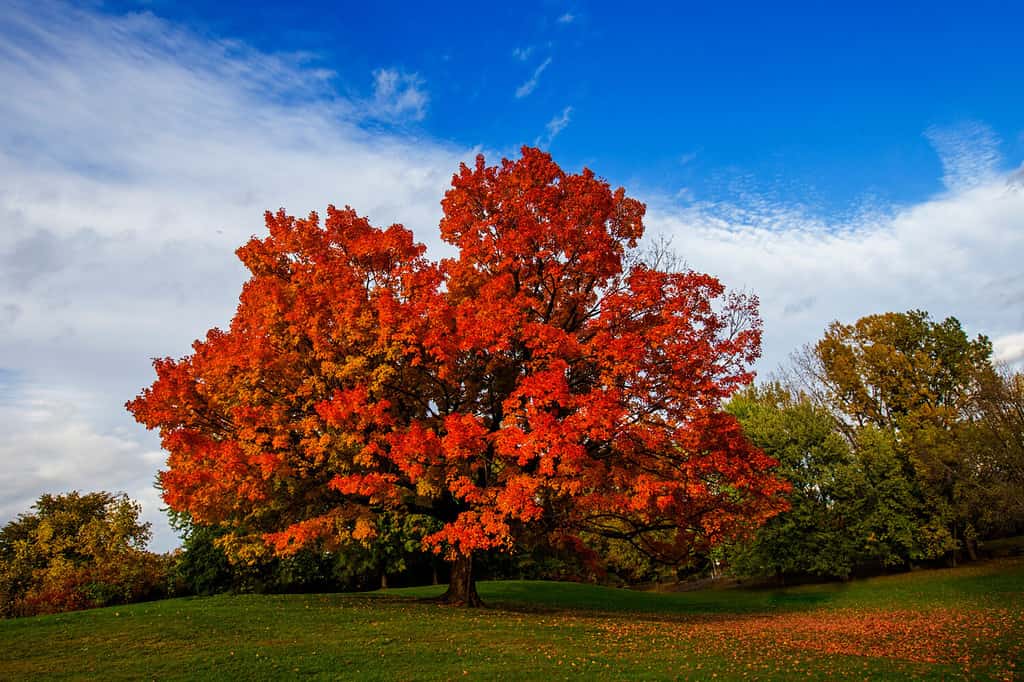
Sugar maples not only produce gorgeous colors in the fall–they also produce maple syrup.
©Mircea Costina/Shutterstock.com
The leaves on this tree turn deep shades of yellow, orange, and red, and the trees can grow upwards of 40-80 feet while spreading out as much as 60 feet. Sugar maples are famous for their ability to produce maple syrup, a breakfast staple for pancakes and waffles in the United States. They thrive in the eastern areas of North America in growing zones 3 to 8.
Amur Maple (Acer tataricum subsp. ginnala ‘Flame’)
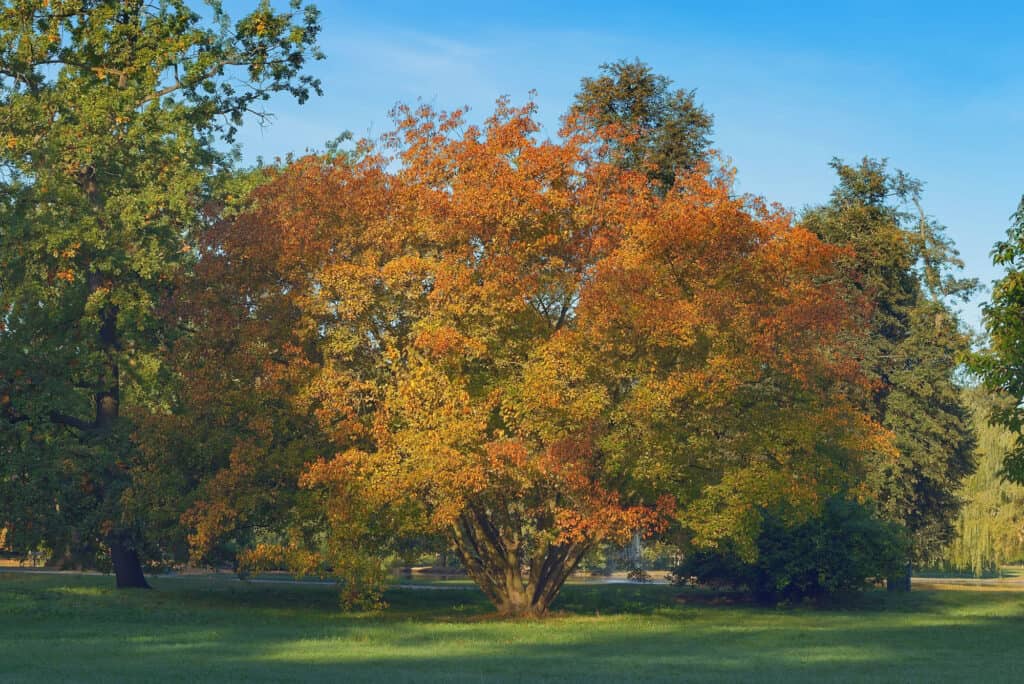
If you are looking for a fairly small landscaping tree, the amur maple may be a good choice.
©arazu/Shutterstock.com
These trees are native to southeastern Europe and western Asia, popular in urban areas because of their compactness. The fall foliage for these modest maples is a brilliant red, sometimes yellow. They can grow in USDA growing zones 2-8, and tend to reach heights of 15-20 feet.
Paperbark Maple (Acer griseum)
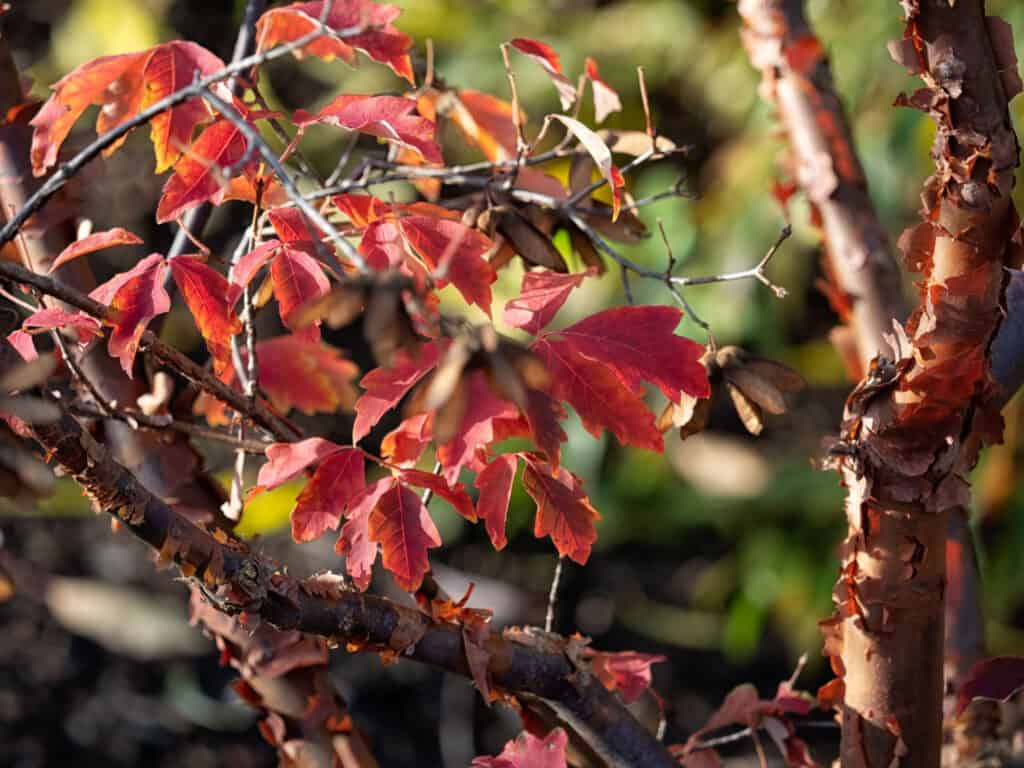
Small and striking, paperbark maples make a great ornamental addition to any landscaping project.
©Chris Lawrence Travel/Shutterstock.com
If you’re looking for a maple with an interesting trunk, try the paperbark maple, whose bark has a peeling appearance similar to a birch tree. Though they originate in central and eastern China, these trees can grow well in USDA Growing Zones 4-8, capable of reaching heights of 20-30 feet. Their fall colors are typically red, though they can also be reddish-green or orange.
The photo featured at the top of this post is © ForestSeasons/Shutterstock.com
Sources
- the Spruce, Available here: https://www.thespruce.com/autumn-blaze-maple-trees-2132093
- the Spruce, Available here: https://www.thespruce.com/autumn-blaze-maple-trees-2132093
FAQs (Frequently Asked Questions)
Do Autumn Blaze® maple trees get very large?
Yes. Autumn Blaze® maple trees can easily become giant, fiery, 50-foot trees.
Is there a difference between the Autumn Blaze® maple and the Red Sunset® maple?
There are a few differences. Red Sunset® maples tend to have larger leaves and less hardiness than their Autumn Blaze® maple cousins. Just as well, the Autumn Blaze® maple tends to grow faster.
Are Red Sunset® maples good trees?
Red Sunset® maple trees are great for backyards and can grow to be about 50 feet tall.
Thank you for reading! Have some feedback for us? Contact the AZ Animals editorial team.






